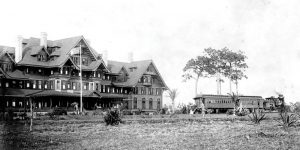125 years ago, Henry Plant built the Belleview Biltmore Hotel in Belleair, FL, located just south of Clearwater on the state’s west coast. Chances are, Mr. Plant would never believe that someday someone would pick up and move his magnificent 5-story hotel, but that is precisely what happened. Working with engineers from Pennoni Associates Inc., the structural engineer of record (SEOR), Wolfe House & Building Movers rotated the original section of the old hotel 50 degrees. Then, they moved it about 350 feet as part of a significant redevelopment project. According to Wolfe, the structure weighed 1,750 tons, making it one of the heaviest framed buildings ever moved. The old hotel was then renovated into the Belleview Inn and is now the center point of a $125 million development that consists of four 8-story condominium buildings and 2-story carriage homes developed by JMC Communities of St. Petersburg, FL.
History
The hotel was constructed with rough sawn timber framing, including roof rafters, floor joists, planking, and load-bearing stud walls. The structure is supported on timber beams that span over a basement and bear on brick piers and exterior brick walls. Three 5-story-deep trusses span 65 feet over the lobby and support the structure above, creating a large column-free space. The trusses were built with heavy timber chords and compression members notched and bolted together. The tension members are iron rods with bolted ends.
Henry Plant opened the hotel in 1897 as a winter destination for northern visitors seeking to escape the cold and snow. It was no coincidence that many people traveled to Florida by train in those days, and Mr. Plant owned the railroads. The hotel underwent major expansions in 1905, 1914, and 1925, increasing the total size to over 400 rooms and 820,000 square feet. It was one of the largest occupied wood structures in the world at that time. Over the years, the hotel guest list included Thomas Edison, Henry Ford, The Brooklyn Dodgers, Bob Hope, Gerald Ford, Jimmy Carter, George HW Bush, and many other dignitaries. It was added to the U.S. National Register of Historic Places in 1979 but then removed from the National Register in 2017.
As time went on, however, the old building started to decline. Modern-day travelers were looking for beachfront access, a golf course, larger rooms – and other amenities that the Biltmore did not offer. The hotel went through a series of ownership changes until it was finally closed in 2009.
In 2010, The Town of Belleair hired Pennoni to conduct annual assessments of the building and document the structural system’s condition. When JMC acquired the property in 2015, it was in bad shape. The wood framing had deteriorated mainly from water intrusion beginning at the roof and progressing downward to the floors below.
After purchasing the property, JMC retained Pennoni to conduct a preliminary analysis of the structural system to help them determine what to do with the old structure. JMC eventually decided to “deconstruct” most of the existing building, preserving the original 1897 lobby portion, which, interestingly, was in the best condition. The deconstruction took much longer to complete than a standard demolition because many of the original building components were salvaged for reuse. For example, the heart pine timber framing went to a wood mill in North Carolina, and doors and windows went to a restoration company in Tampa. In addition, many original building components, like the Tiffany glass in the ballroom, were preserved for use in the new inn, along with much of the artwork.
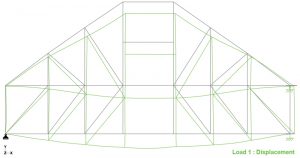
Engineering Challenges
Wolfe evaluated the existing structure before the move to identify the lifting load points and add temporary steel framing where needed to stabilize the building during the move. Next, they installed temporary steel beams under each load point along with 45 Buckingham wheeled dollies. Finally, the entire structure was lifted, rotated, and moved via remote control to its new location, where a new concrete mat foundation, cast-in-place concrete walls, and concrete piers were built. This presented an unusual phasing challenge because the new walls and piers needed to be positioned under the load-bearing points that were being supported by the temporary steel beams during the move. To resolve that problem, the SEOR modified the design of the piers and walls to allow for the phased removal of the beams without losing support under the building.
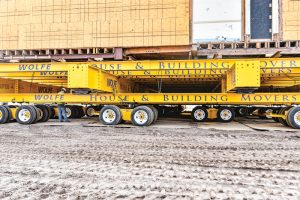
After the hotel was relocated and safely supported on its permanent foundation, Pennoni completed an in-depth structural analysis to make it safe for occupancy. As a result, the existing plaster on the walls and ceilings and the roof shingles were removed to allow visual access to the framing system. An added benefit is that the replacement drywall and new roof materials weighed considerably less.
The most significant structural damage occurred at one end of the middle lobby truss, where the short timber beam that supported it had failed and deflected. This failure resulted in noticeable deflection of the floors above. Structural steel columns and beams were designed to repair the failed beam, and the truss members were cover-plated with bolted steel plates to restore their integrity. The engineering team initially considered jacking up the deflected floors to level them but quickly rejected that idea because it would have caused more damage to the wood framing. Instead, it was decided to use a combination of shimming and a lightweight leveling compound to level the floors.
Other less critical damages, including deterioration from water intrusion, old improper repairs, excessive splitting and checks in the timber, and insect damage, were found throughout the building. The SEOR worked closely with the framing subcontractor, who was very experienced at historical renovation, to develop repair details in the field. This was made possible because Pennoni was on site frequently as the Florida Threshold Inspector.
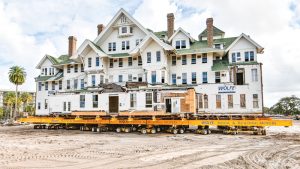
The lobby trusses were analyzed using STAAD Pro software with assumed worst-case material properties, approximated member end conditions, actual dead loads, and full live loads from the Florida Building Code. The trusses were found to be acceptable. A separate load case was run to confirm assumptions, representing the historic live and dead loads with an added long-term creep factor. The resulting deflection was reasonably close to the measured truss deflection, confirming the design approach.
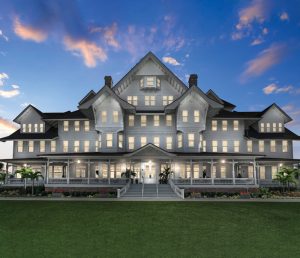
Summary
JMC Communities is well known for developing high-quality residential projects. Although they spent a lot more time and money than anticipated to save, relocate, and renovate the old Belleview Biltmore Hotel, JMC said preserving a piece of history was the right thing to do. The team is sure Henry Plant would be pleased.■

